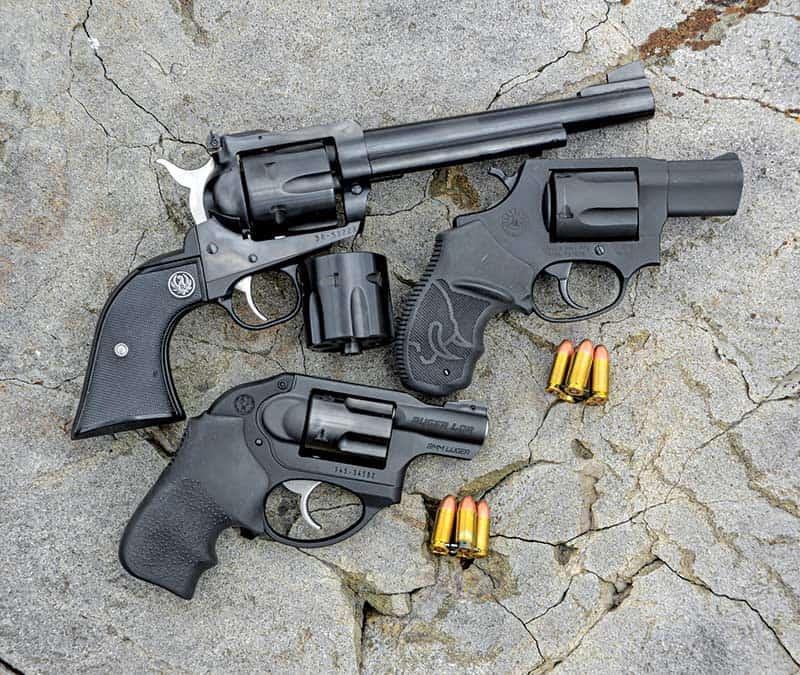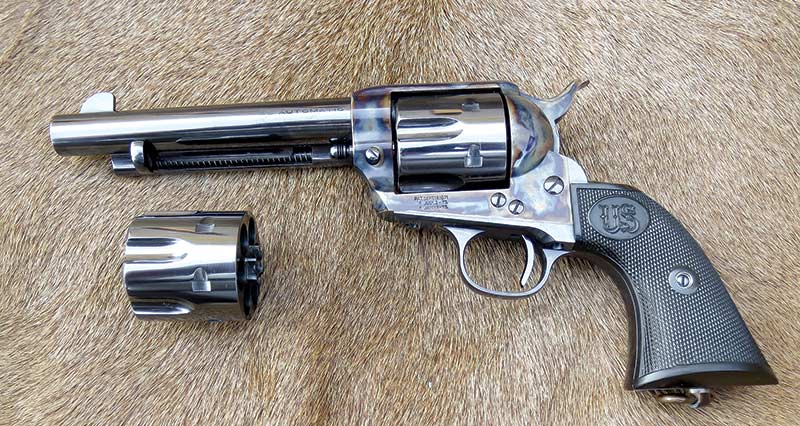It’s odd how some things stick in your mind and others fly away as in a stiff wind. For instance, I can’t remember to whom about 40 years ago I sold a 6″-barreled S&W Model 19 .357 Magnum. (I’d like to have it back.) However, I clearly remember a magazine article Skeeter Skelton wrote over 50 years gone by. In it he related in his youth he somehow got his hands on a Colt SAA Bisley Model stamped .41 Colt. But it was minus its cylinder. He took it to the local gun expert who put a .38-40 cylinder in it and said, “There, now you have a .38-40 because .41 Colts and .38-40s use the same barrel bore/groove dimensions.” (Or something like that. Remember it was over 50 years ago.) The young Skeeter was confused then as was I being a young reader.
Cylinder Swap Meet
Right now on my desk is a 1904 vintage Colt SAA .38-40. With it is a .41 Colt cylinder that fits and times perfectly. What’s more the old sixgun shoots fine with proper ammo from either cylinder. According to a factory spec sheet dated 1922, Colt used 0.401/0.402″ for groove diameter for all their .41s and .38-40s. Factory loads for .41 Colt at that time had 0.386″ soft lead bullets with deep hollowbases, so they would expand to grip rifling. Factory .38-40 loads used 0.400″ bullets.
Such a capability is one of the single action genre of handguns’ best benefits. As long as barrel bore specs are the same, switching cylinders to a different cartridge is a cinch. All that must be done with traditional SAs is half cock the hammer, open the loading gate, pull the base pin and drop out the current cylinder. To install another just reverse the process. With Ruger New Model single actions just start with opening the loading gate.
Ruger still catalogs their .357 Magnum/9mm Luger and .45 Colt/.45 Auto New Model Blackhawk Convertibles, along with their .22 Single Six Convertible with .22 LR and .22 WMR cylinders. I’ve owned or used them all. Once I was loaned a rare New Model Blackhawk .38-40/40 S&W convertible that shot superbly. However, I totally missed the .30 Carbine/.32-20 New Model Blackhawk Convertible.
Colt made a small run of their 4″ barreled “Storekeeper” Models with both .45 Colt and .45 Auto cylinders and sold many more 3″ barreled “Sheriff’s Models” with both .44 Special and .44-40 cylinders. I had one of the former. With the .44 Special cylinder in place, I still use one of the latter with shot loads as my primary rattlesnake revolver during warm months.
Perhaps the most unusual dual cylindered single action I’ve ever owned was from the now defunct United States Firearms Company. They called it their Battle of Britain Single-Action. It was full blued, beautifully crafted with 5½” barrel, lanyard looped in the butt and caliber stamped .45 Automatic. Of course, it also came with a .45 Colt cylinder.
Versatility Pays Off
These last few years I’ve been picking up good Colt SAAs if the price is reasonable and inevitably my storage area was getting crowded. Then one day I got a brainstorm, “Why keep my two 3rd Generation .44 Specials? Why not sell them and let the money raised finance .44 Special cylinders for my 3rd Generation .44-40s?” I did just that but must say the search wasn’t quick or simple for I needed one nickel-plated and the other blued. I spent months searching classified ads on websites or gunbroker.com auctions, but eventually my persistence paid off. The blued one had to be engraved with a gold line inlaid around it. This wasn’t a problem as I knew the SAA’s original engraver. It just added time and money to the project.
Now some very intelligent reader is thinking, “But, your .44-40s are factory sighted for 200-grain bullets and will shoot high with the 240/250-grain bullets normal for .44 Specials. Correct! But it just so happens I have a nice four-cavity bullet mold for 200-grain round nose .44 bullets of 0.430″. So, my self-made convertibles are easy to hit with using either cylinder.
In a time when handguns are becoming increasingly utilitarian, I appreciate single actions for their gracefulness and versatility.


